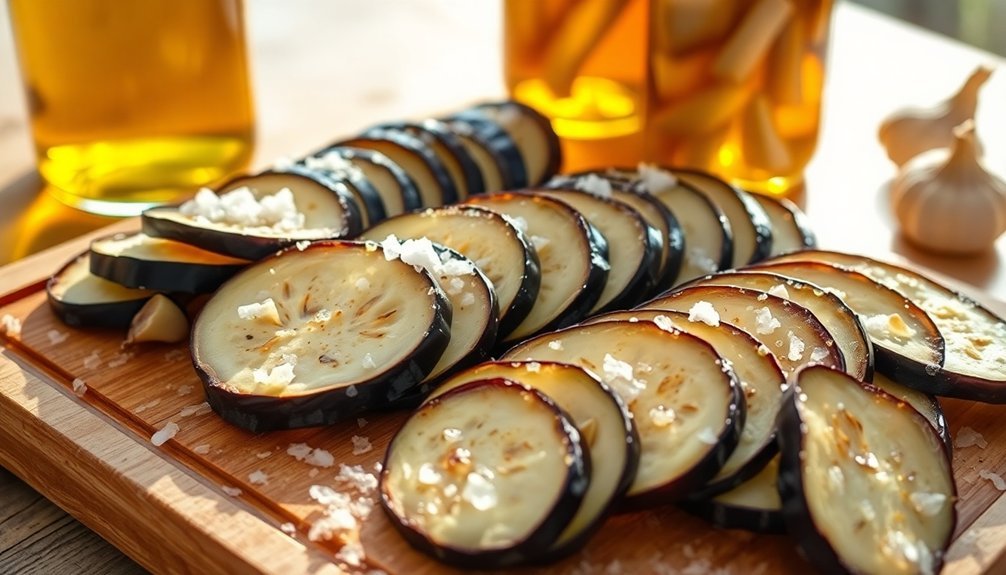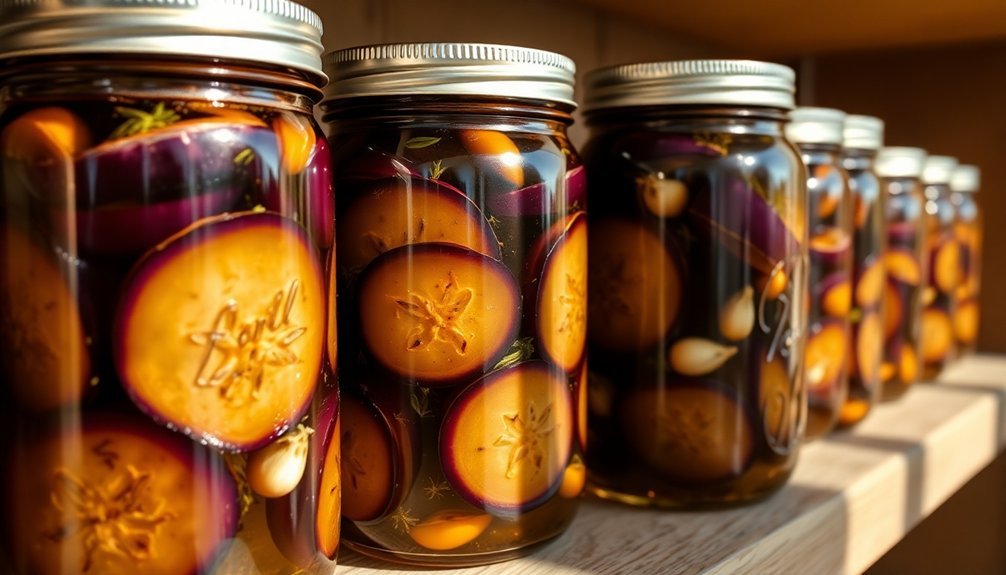To create authentic Italian oil-preserved eggplant, you'll need to master seven essential methods. Start by salt-curing your sliced eggplant overnight to remove bitterness and excess moisture. Next, grill the pieces to golden-brown perfection before marinating them in your choice of herbs, garlic, and vinegar. When preserving, sterilize your jars properly and layer the eggplant carefully, ensuring complete olive oil coverage to prevent spoilage. Regional variations range from spicy Southern Italian to Northern herb-forward recipes. Proper storage in a cool, dark place allows flavors to develop for up to a year. These traditional techniques hold the key to antipasto mastery.
Traditional Salt Preparation Method

Nearly every Italian antipasto preparation involving eggplant begins with the fundamental salt preparation method.
You'll need to start by cutting your eggplant into your desired pieces, whether they're slices or strips, before generously sprinkling salt over them. This vital step helps remove the vegetable's natural bitterness while simultaneously reducing its moisture content.
Let your salted eggplant pieces rest for several hours or overnight, allowing the salt to draw out excess water. You'll notice water pooling around the eggplant – this is exactly what you want.
Once the resting period is complete, thoroughly rinse the eggplant to remove the excess salt, then pat the pieces dry with a clean cloth or paper towels.
If you're short on time, you can skip the salting process, but you'll need to compensate by increasing your parboiling time to 3-5 minutes in well-seasoned water. Using clean sterilized jars for storage is essential for food safety.
However, for traditional antipasto preparations, salting isn't just about flavor – it's critical for preservation. The reduced water content makes it harder for bacteria to grow, extends shelf life, and guarantees your preserved eggplant maintains the perfect texture when stored in oil.
Essential Marinades and Seasonings
A well-crafted marinade forms the heart of any Italian antipasto, particularly for eggplant preparations. You'll want to start with extra virgin olive oil as your base, combined with either balsamic or white wine vinegar for the perfect acidic balance.
Fresh minced garlic and a careful blend of dried herbs like oregano, basil, and Italian parsley create the signature Mediterranean flavor profile. The tender texture of properly marinated eggplant makes it perfect for grilling without losing its shape.
To achieve the best results, whisk your marinade ingredients together in a bowl or mason jar before gently tossing with your eggplant slices.
You can enhance your marinade's complexity by incorporating these additional elements:
- Fresh parsley as a vibrant garnish and flavor booster
- Red hot chili peppers or pepper flakes for a spicy kick
- Lemon juice for a brighter acid profile
- Sea salt for depth and mineral notes
Your marinated eggplant will develop deeper flavors over time, whether you're planning to serve it within 15 minutes or preserve it for weeks.
If you're looking to create a long-term preservation, consider curing your eggplant in oil with garlic and herbs in sealed mason jars, stored in the refrigerator.
Grilling for Perfect Texture

Getting the perfect texture for grilled eggplant requires careful attention to both preparation and technique.
Before grilling, you'll need to slice the eggplant into 1/2-inch rounds, trim the edges, and cut off the leafy end last to maintain your grip. Salt the slices generously and let them sit for 20-30 minutes to draw out excess moisture, then pat them dry. Globe eggplants are ideal for slicing and widely available in most markets.
You'll want to preheat your grill or grill pan to medium-high heat. If you're using a grill pan, start with a coating of cooking spray, then lightly oil the surface. For outdoor grills, oil the grates and close the lid to trap heat.
Once the grill is fully heated, brush your eggplant slices with olive oil on both sides.
Place the slices in a single layer and grill for 3-5 minutes per side. You're looking for golden-brown coloring, char marks, and fork-tender texture. Keep flipping the slices every 3 minutes if needed to guarantee even cooking.
Don't leave them on too long – you want caramelization without mushiness. The perfect grilled eggplant should be tender but still hold its shape.
Oil Preservation Technique
You'll need properly sterilized jars to prevent bacterial growth and guarantee your preserved eggplant stays fresh over time.
Pressing down each layer of eggplant while filling the jars eliminates air pockets and guarantees complete oil coverage.
Maintaining the olive oil level above the eggplant is essential, so you'll want to top off the jars with additional oil whenever some is removed during use.
Sterilizing Jars For Success
Proper sterilization of jars stands as the cornerstone of successful oil preservation for Italian antipasto. You'll find several effective methods to guarantee your containers are ready for your preserved vegetables, with the oven technique being particularly reliable for oil-based preparations.
For oven sterilization, heat to 275°F/130°C, wash your jars thoroughly, and place them on a baking sheet without touching. Let them sterilize for 10-20 minutes until completely dry. You'll need to handle them with oven mitts when they're ready.
When it comes to preserving your Italian antipasto creations, you'll want to take into account these critical sterilization factors:
- Always use new lids or wax discs if your existing ones show any signs of damage or rust.
- Don't put rubber seals in the oven – boil them separately for 2-5 minutes instead.
- Keep your jars hot when filling them with preserves to guarantee proper sealing.
- Sterilize extra lids to account for any additional preserve mixture.
Whether you choose the oven, dishwasher, or microwave method, guarantee your jars are spotlessly clean before starting the sterilization process.
Proper Oil Coverage Method
Once your jars are sterilized, mastering the oil coverage technique becomes your next vital step in antipasto preservation.
You'll need to layer your prepared eggplant strips carefully in the jars, alternating with cherry peppers, garlic, and parsley. As you build each layer, press down firmly to eliminate air pockets that could compromise preservation.
Extra virgin olive oil is your essential preservation medium. You'll want to pour it gradually over your layered ingredients, ensuring complete submersion of the eggplant. Leave about an inch of headspace at the jar's top, and use a spoon to press down the ingredients, allowing any trapped air bubbles to escape.
Don't forget to add fresh basil leaves or dried chili peppers on top before the final oil pour.
After sealing your jars, you'll need to maintain proper oil coverage throughout storage. Each time you remove some eggplant, top off the jar with additional oil to keep the vegetables submerged.
Store your jars in the refrigerator, away from light and heat. If the oil congeals, simply run the jar under warm water before serving.
With proper oil coverage, your antipasto can last for months while maintaining its authentic Italian flavor.
Jar Preparation and Storage

Starting with thoroughly sterilized equipment is essential for safe antipasto preservation. You'll need to boil your jars, lids, rings, and utensils in a vinegar-water solution to eliminate any contaminants. After sterilization, dry the jars upside down to remove excess moisture before adding a thin coating of oil to the bottom.
When you're ready to pack your eggplant, remember these critical steps:
- Layer the eggplant strips with fresh basil leaves, pressing firmly with a fork to remove air pockets
- Add your chosen seasonings like garlic, dried chili peppers, and oregano between layers
- Maintain proper oil coverage while leaving ¼" headspace at the top
- Top with additional ingredients like fennel seeds or dried red peppers if desired
Don't tighten the lids completely at first – let the jars sit for a few hours so the eggplant can absorb some oil.
Once you've adjusted the oil levels, seal the lids tightly and store in a cool, dark place. Your preserved eggplant will need at least a week to develop its flavors, but waiting a month will give you the best results.
When stored properly, these antipasto jars can last up to a year.
Regional Recipe Variations
Throughout Italy's diverse regions, antipasto recipes showcase distinct local ingredients and traditional preparation methods. You'll find variations in marination techniques, with some areas favoring a simple mix of extra virgin olive oil, lemon, and garlic, while others incorporate white or red wine vinegar for a sharper flavor profile.
In southern regions, you'll notice more frequent use of hot pepper flakes and oregano, creating zesty marinades that complement the eggplant's natural flavors. Northern Italian preparations often include pine nuts and aged sheep's milk cheeses, adding rich, nutty elements to the dish. Some coastal areas incorporate seafood-friendly herbs like mint, while inland recipes might feature heartier accompaniments like salumi.
The preparation methods also vary by region. While some areas traditionally peel the eggplant before slicing, others leave the skin intact for added texture. Slice thickness ranges from delicate ¼-inch strips to heartier 1-inch cuts.
You can adapt these regional differences by incorporating local vegetables like bell peppers, zucchini, or artichoke hearts into your antipasto. For authentic regional flair, try pairing your preserved eggplant with area-specific cheeses and cured meats.
Serving Your Preserved Eggplant

Building on these regional traditions, your preserved eggplant can take center stage in a variety of serving presentations. You'll find it's incredibly versatile, working beautifully as part of an antipasto platter alongside crusty bread, grissini, and a selection of Italian cheeses and cured meats.
For maximum impact, serve your preserved eggplant in these popular ways:
- As a star ingredient on charcuterie boards, paired with aged sheep's milk cheeses and premium salumi
- Layered in sandwiches or wraps with fresh mozzarella and caramelized onions, enhanced with aioli or balsamic
- As a standalone appetizer, served at room temperature with crackers or rice cakes for gluten-free guests
- Incorporated into an antipasto spread with tapenades, olives, and pickled vegetables
When arranging your preserved eggplant, focus on creating visually appealing presentations that invite guests to explore the flavors.
You can dress up crostini with eggplant for quick appetizers or add it to bruschetta for an elegant twist. Don't forget to include small jars of complementary condiments like tapenades and aioli to enhance the overall experience.
Frequently Asked Questions
Can I Substitute Regular Vinegar With Balsamic Vinegar for Preserving?
You shouldn't substitute balsamic vinegar for regular vinegar in preserving, as it's not acidic enough to guarantee food safety. If you'd like to use it, combine it with white vinegar for proper preservation.
Why Do Some Eggplants Turn Brown Even When Preserved Properly?
Even with proper preservation, your eggplants might turn brown due to oxidation, high moisture content, or inadequate acid levels. You'll want to guarantee they're completely submerged in oil and stored in cool, dark conditions.
Is It Safe to Add Fresh Garlic to Oil-Preserved Eggplant?
You shouldn't add fresh garlic to oil-preserved eggplant due to botulism risks. Instead, acidify the garlic with vinegar or heat it thoroughly before adding. Always store your preserved mixture in the refrigerator.
How Long Should I Wait Before Eating Newly Preserved Eggplant?
You'll need to wait at least one week before eating your preserved eggplant, but it's best to wait even longer. The flavors improve over time, making it more delicious after several weeks.
Can Frozen Eggplant Be Used for Oil Preservation?
You shouldn't use frozen eggplant for oil preservation, as it's likely to become mushy and affect the final texture. Stick with fresh eggplant for the best results in your preserved antipasto dishes.
In Summary
Now you're ready to enjoy your homemade oil-preserved eggplant antipasto. You'll find it's worth the effort when you taste the rich, perfectly seasoned results. Keep your jars stored in a cool, dark place and they'll last for months. Don't forget to experiment with different regional variations and seasonings to discover your favorite style. Serve your antipasto with crusty bread and good wine for an authentic Italian experience.





Leave a Reply